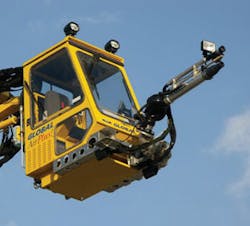One truism regarding ground aircraft deicing is the more things change, the more they stay the same. One thing will always remain so — aircraft whose critical surfaces are contaminated with snow, ice, slush or other frozen goo will have a much harder time getting in the air and staying there. However, the methods used to remove that contamination has changed dramatically over the last 10 years.
A series of accidents a few decades ago gave ground deicing greater visibility. This resulted in an industry-wide need for a group of individuals who specialized in aircraft deicing, which eventually led to the creation of the SAE (Society of Automotive Engineers) Technical Committee G-12 Aircraft Ground Deicing. The fact sheet for G-12 summarizes it best.
“The SAE G-12 Aircraft Ground Deicing committee addresses all facets of aircraft ground deicing equipmen design, maintenance, operation and in-service experience. It provides a focal point for the related activities of the various specialty groups and committees dealing with aircraft ground deicing. The group is comprised of eight subcommittees dedicated to creating, preparing and maintaining all relevant specifications, standards and requirements for aircraft ground deicing systems.
Participants in the SAE G-12 committee include OEMs, suppliers, aircraft ground deicing equipment companies, consulting firms, governments and others across the aerospace and defense industries.”
This year the G-12 meeting saw record attendance. There were representatives from almost every North American and European carrier, regulators from the US, Canada, Europe and Asia, equipment and fluid manufacturers and too many others to mention. The subcommittee meetings overlap and run from Sunday to Thursday, which allows participants to attend only those meetings that are needed. I would summarize the entire conference as a group whose goal is to deice aircraft safely and effectively with as little impact to the operation and environment as possible.
One thing was very clear during most of the meetings, the environmental regulatory agencies around the world are paying much closer attention to the amount of deicing/anti-icing fluid used and the airlines and airports ability to recover and remediate this fluid. Some of the focus was on large scale facilities that can recover and recycle fluid, but with the year after year increase in the cost of deicing and anti-icing, the main focus was on reducing the amount of fluid sprayed.
Global Ground Support, FMC and Vestergaard all did presentations on their in-truck blending systems. These systems allow users to only spray the concentration of glycol required for the outside air temperature. A review of data from last season for one airline hub that uses a standard 55/45 blend showed that more than $2 million would have been saved if proportional deicers had been used.
Another new technology that has proven to dramatically reduce glycol use is “forced air”. Forced air systems use a turbocharger to produce a 700+ MPH stream of air. This air stream can be used by itself to remove snow or ice from an aircraft without the use of glycol or in conjunction with the high or low flow Type 1 systems.
I was able to spend several days this winter at a deicing pad that uses trucks with our “AirPlus” system. They were deicing two same model ERJ planes in light snow, 31 degrees farenheit with two trucks per aircraft. The first aircraft was deiced with the standard Type 1 system, 67 gallons of dilute type 1 was used. The deicers then used the low flow nozzles for the second aircraft, 31 gallons were sprayed. The third aircraft then taxied into position and the trucks used the forced air option with hot Type 1 fluid injected into the air steam at a rate of 7 GPM. The total fluid used for both trucks was seven gallons, resulting in a 90 percent reduction in fluid and no increase in the time it took to deice the aircraft.
Until 2006, the air systems were only used for deicing. A major cargo carrier tested the use of the air system in assisting the application of Type IV anti-icing fluid. This process has since been approved by the FAA and Transport Canada and resulted in a 40 percent Type IV savings for the user this season. We know this system has helped our customers reduce both Type 1 and Type IV glycol use because, since its introduction in 2000, more than 60 percent of the deicers Global has sold have had this option chosen by customers.
There is a second variable cost for the end user — manpower. Most employees receive mandatory deicing training during the late summer or early fall, four to five months before they actually deice. This long hiatus can severely affect an employees proficiency and productivity. They spend the first few deicing events getting reacclimated. When the first deicing simulator was introduced nearly two years ago, it allowed operators to train employees in a cost0effective and efficient manner. Unfortunately, some airlines don’t understand the glycol and time wasted would pay for several simulators a year. A supervisor can choose the aircraft, type of precipitation and observe the operators performance and fluid usage.
These simulators are also a great training tool for the second greatest cost saver — single operator deicers. These deicers allow the individual in the deicing bucket or cab to control all movements of the chassis and boom, while reducing manpower costs by half. However, the single operator units are more complicated to operate and require the operator to be more proficient, another reason for training that can be practiced throughout the year.
This and many more topics on aircraft ground deicing equipment were discussed at the SAG-12 meeting in May. The meetings give everyone an opportunity to network with peers to discuss the previous season and struggles. Having attended these meetings as both a user and a vendor, I can not stress how important they are to anyone involved in any aspect of winter operations.







